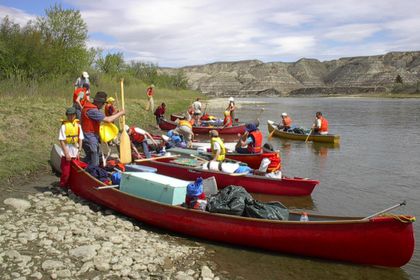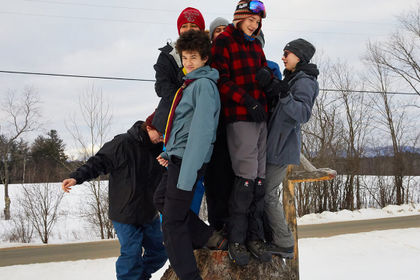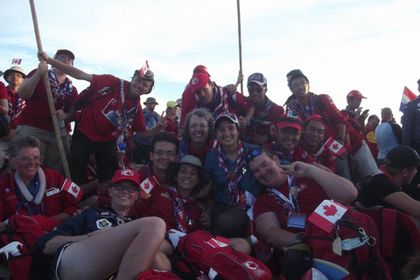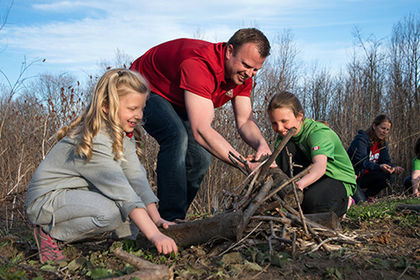The Four Key Elements:
- Youth-led: The program is directed by its youth members—not the Scouters.
- Plan-Do-Review: The three-step process that informs all activities in the Canadian Path program.
- Adventure: It’s about exploring new things, sharing new ideas, learning new skills and creating new paths
- SPICES: The acronym for the six dimensions of personal development that are embedded within the Canadian Path program – Social, Physical, Intellectual, Character, Emotional and Spiritual.
Youth-Led
Since the very beginning of the Scouting movement, the vision for Scouts has been that the youth take responsibility for their activities and adventures. Scouts play the most important role within their Sections, and Scouters give them the opportunity to step up and help run the program.
Youth decide what activities they want to do, what adventures they want to undertake and what challenges they wish to give themselves. Youth bring their own ideas and interests to the mix to create adventures in all six Program Areas so that the program truly becomes their own. Our Scouters have an active role in mentoring, encouraging, guiding and inspiring youth.
Plan-Do-Review
Plan: All youth are involved in the planning process—brainstorming, making suggestions and providing input about the Program Areas they are interested in. Then, with guidance from their Scouters, youth select the activities they will pursue along their Path. Scouters engage all youth in the planning for age-appropriate activities and adventures.
Do: Everyone—youth and Scouters—is involved in the planned activities, and all youth are engaged and challenged in ways appropriate to their abilities. It’s all about creating a well-rounded program full of fun and adventure that nurture and inspire all youth.
Review: At the end of an activity, or at the next Scout meeting, youth and Scouters will take time to talk about their experience. This is an important part of the process for all Scouting activities. It’s where youth reflect upon their personal growth, where they can improve and to help recognize ways to do things in the future.
Adventure
The image of youth exploring in the wilderness is one of the first ideas that springs to mind when thinking about Scouting. Imagine Beaver Scouts catching fireflies at a local Scout camp, or Venturer Scouts taking a helicopter to a remote wilderness in the Rocky Mountains and hiking out. It’s what many members of Scouting love about the program, and it’s what compels a lot of people to come see what Scouting has to offer them.
It’s important to recognize that Adventure isn’t always something physically evident. Adventure is about exploring new things, sharing new ideas, learning new skills, and creating new paths. Whether youth are pursuing outdoor challenges, experimenting with STEM concepts, exploring their faith, or tackling a project related to personal expression or community development, they are growing as individuals by having new experiences.
SPICES
The acronym for the six dimensions of personal development, the SPICES gives the Scouts Canada program a useful framework to ensure well-rounded program offerings.
At each Section level, Scouters use The Canadian Path to support youth development and growth in each of the following areas:
Social: Through participation in Scouting adventures, youth begin to understand how they depend on others, and how others depend on them. Scouting adventures allow them to be part of a diverse group and develop cooperation and leadership skills.
Physical: Scouting adventures provide many opportunities for youth to be responsible for the care and wellbeing of their bodies.
Intellectual: Through Scouting adventures, youth have opportunities to develop in their ability to think, to plan, to innovate and to use information in an original way to adapt to new situations.
Character: Scouting adventures guide youth to take responsibility for themselves while still respecting the needs of others, helping them to create a lifelong personal values system.
Emotional: Through Scouting adventures, youth members are given opportunities to recognize and respect their own feelings and to learn to express them in a healthy manner while respecting the feelings of others.
Spiritual: In the midst of Scouting adventures, youth members have experiences in which they recognize that they are part of a larger spiritual reality and learn to respect the spiritual choices of others. (Note: The larger spiritual reality could include, but is not limited to: a relationship with God, Allah, Jehovah, Heavenly Father, Supreme Being, the eight-fold path of Buddhism, a Higher Power, a connection with nature and the earth and a connection with the global community.)

The Six Program Areas
The Canadian Path is divided into six Program Areas—categories of the different opportunities that Scouting offers. Each Section explores all of the Program Areas through age-appropriate activities.
Including features from multiple Program Areas makes the adventure more challenging and encourages development in all of the SPICES. Remember, the Canadian Path is Youth-Led, so the youth will decide on adventures for every Program Area. Below are some areas of the fantastic possibilities the six Program Areas can provide.
Environment & Outdoors
Adventure in this Program Area involves exploring, hiking, camping, paddling and other ways of enjoying the outdoors. Youth also learn new skills around environmental stewardship and Leave No Trace. This Program Area fosters an understanding of:
- Learning about and interacting with nature and the environment
- Learning how to enjoy, respect and live in the outdoors
- Preparing for camping, hiking and other outdoor activities
- Developing safety and survival skills
- Caring for, protecting and understanding our interdependence with the environment
Leadership
Through adventures in this Program Area, youth learn about and practise the skills of being good leaders in their Section, community and Canada. Youth can expect to explore things like:
- Learning to lead in their Lodges/Lairs/Patrols/Crew as well as within their Section and larger groups and even within their community
- A variety of leadership styles
- Acting as a mentor for other youth in Scouting
- Learning what makes a good leader, as well as a good team player.
Active & Healthy Living
During adventures in this Program Area, youth are involved in playing, having fun and being active while they develop good mental and physical habits for happy and healthy living. Youth can expect to explore things like:
- Learning about health and fitness
- Exploring the benefits of a healthy lifestyle
- Experiencing a variety of options for fitness and joy in movement
- Respecting and understanding the diversity in body types and appearances
- Incorporating healthy activities in all aspects of life
- Making wise and healthy choices
- Learning first aid skills and what to do in emergency situations
Citizenship
This Program Area covers learning about being good citizens in their community, in Canada and in the world. Youth can expect to explore:
- Learning about their local community, Canada and the global community
- Offering service to Canada and to other communities
- Leading linking activities with younger Scouting Sections
- Learning about being a good citizen through participation in democracy and gaining knowledge of Canada’s history, form of government, legal system etc.
- Understanding the interdependence that exists between people and between countries
- Participating in activities such as Jamborees that create connections beyond their local community
Creative Expression
During adventures in this Program Area, youth are involved in sharing and exploring their own creative expression and understanding the creative expression engaged by others. Youth might try:
- Exploring a variety of creative pursuits in visual arts, music, spoken arts, digital arts, drama and more.
- Increase skills in areas of personal interest
- Offer leadership to the Section in an area of personal interest or expertise
- Use imagination in problem-solving and working as a team
- Recognizing the benefit of including a variety of skills, interests and perspectives in a working team
Beliefs & Values
During adventures in this Program Area, youth explore personal values and beliefs as well as the diversity of cultures and faiths that make up our communities, our nation and our world.
- Exploring and reflecting upon the beliefs, values and attitudes that are part of our society
- Understanding our own beliefs, values and attitudes in relation to others
- Respecting the diversity of culture and faith
- Developing group, team and individual codes of practice in relation to the environment, working together and being a Scout

Outdoor Adventure Skills
The Outdoor Adventure Skills program is an invitation for Scouts to try something new—to be outside more, testing themselves with progressive challenges while remaining within their capabilities to stay safe. In short, it’s about having life-changing experiences.
As part of the Outdoor Adventure Skills program within the Canadian Path, there are nine different Skills set, each divided into nine achievement levels:
|
Paddling
|
Winter
|
Vertical
|
|
Aquatics
|
Camping
|
Scoutcraft
|
|
Emergency
|
Trail
|
Sailing
|
Learn more about all nine Skills and their achievement levels by visiting the Outdoor Adventure Skills page.
Outdoor Adventure Skills









